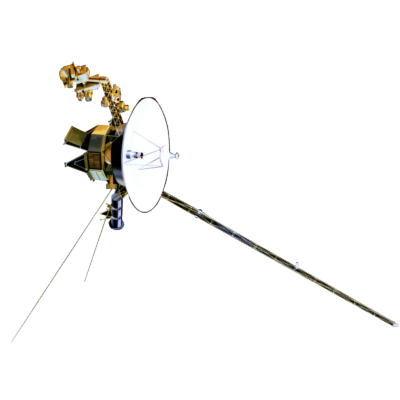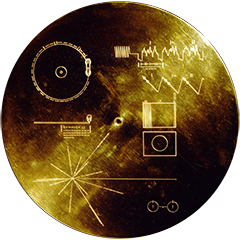Voyager LECP Data Analysis Handbook
Data File Descriptions
Super Average Tape Record Description
EFFECTIVE 9/1/91
PHYSICAL RECORD LENGTH: 10000 BYTES
LOGICAL RECORD LENGTH: 10000 BYTES
INCLUDING FOLLOWING 15 BLOCKS
Overall Record Block Organization
| ITEM | BLOCK NAME FORTRAN DECLARATION |
DATA TYPE* | DESCRIPTION | BYTE LOCATION |
|---|---|---|---|---|
| 1 |
HEADER IHEAD(100) |
I*2 /A*2 (mixed) |
100 ITEMS | 1 - 200 |
| 2 |
COUNT RATES RATES(100,10) |
R*4 |
100 CHANNELS * 10 SECTORS |
201 - 4200 |
| 3 |
UNCERTAINTIES OF RATES IUNCS(100,10) |
I*2 |
100 CHANNELS * 10 SECTORS |
4201 - 6200 |
| 4 |
SAMPLE NUMBERS NSAMP(100,10) |
I*2 |
100 CHANNELS * 10 SECTORS |
6201 - 8200 |
| 5 |
RATE RATIOS IGAM(50) |
I*2 | 50 ITEMS | 8201 - 8300 |
| 6 |
COMPOSITION RATIOS ICOMPR(30) |
I*2 | 30 ITEMS | 8301 - 8360 |
| 7 |
ANGULAR RATIOS IANGER(20) |
I*2 | 20 ITEMS | 8361 - 8400 |
| 8 |
RATE RATIO UNCERTAINTIES IUGAM(50) |
I*2 | 50 ITEMS | 8401 - 8500 |
| 9 |
COMP. RATIO UNCERTAINTIES IUCOMP(30) |
I*2 | 30 ITEMS | 8501 - 8560 |
| 10 |
ANGR. RATIO UNCERTAINTIES IUANGR(20) |
I*2 | 20 ITEMS | 8561 - 8600 |
| 11 |
RATE CORRECTION FACTORS IGFLX(100) |
I*2 | 100 CHANNELS | 8601 - 8800 |
| 12 |
COMP. CORRECTION FACTORS ICFACT(100) |
I*2 | 100 CHANNELS | 8801 - 9000 |
| 13 |
FLUXES FLUXES(100) |
R*4 | 100 CHANNELS | 9001 - 9400 |
| 14 |
UNCERTS. OF FLUXES IUFLUX(100) |
I*2 | 100 CHANNELS | 9401 - 9600 |
| 15 |
ANGULAR RESOLUTIONS ISTP(100,2) |
I*2 | 2 * 100 CHANNELS | 9601 - 10000 |
* I*2 = DEC 2 BYTE INTEGERS; R*4 = DEC 4 BYTE REALS; AND A*2 = ASCII 2 CHARACTERS.
The purpose of Scan Average records is to carry the information from a “complete” LECP scan. The stepping motor, however, is commandable into a variety of modes, including “parked”. Thus, the cadence of SCN records is variable and driven by the stepping motor operation. Another substantial complication occurs because in some stepping and data sampling mode combinations, certain LECP channels are undersampled and an accumulation that is read out in a certain sector may have included time while LECP actually pointed in earlier sectors. Since motor position 8 for the “0 degree” channels and motor position 4 for the “180 degree” channels has a shield of about 1 mm Al equivalent thickness as well as alpha and beta emitting in-flight calibration sources, it is important to flag directionally mixed data. We flag it rather than omit it. Item 15 contains the results of the directional analysis done by the scan-averaging procedure. Fluxes, spectral exponents, abundance rations, and angular rations are calculated, given sufficient statistical precision, for the sector 10 (scan-average) data. The interpretation of the directional index, Sectors 1-10, is as follows:
| Motor Position | Sector | Description (look directions) |
| 0 | 1 | Generally points near the sun; early in mission some channels respond to sunlight |
| 1 | 2 | Nominal 45 degrees east of sun |
| 2 | 3 | Nominal 90 degrees east of sun |
| 3 | 4 | Nominal 135 degrees east of sun |
| 4 | 5 | Nominal anti-solar |
| 5 | 6 | Nominal 135 degrees west of sun |
| 6 | 7 | Nominal 90 degrees west of sun |
| 7 | 8 | Nominal 45 degrees west of sun - has background shield and calibration sources |
| Unknown | 9 | A place to retain rates that the software has insufficient information to associate with a motor position |
| 0 thru 6 | 10 | Best estimate of scan average excluding 8, the shielded sector, or 1 (sunlight affected for certain channels). Data will be present in sector 10 if only 1 valid sector is found. |
General comments on the LECP stepping modes:
Early in mission:
V2 was parked for about 90 days in
1977.
V1 and V2 used limited scan avoiding Sector 1 until 1980
(post-Jupiter).
Limited scan is: 2-3-4-5-6-7-8-8-7-6-5-4-3-2-2-3-4-5-6-7-8,
…
Full scan is 1-2-3-4-5-6-7-8-8-7-6-5-4-3-2-1-1-2-3-4-5-6-7,…
Since the LECP data can be acquired in modes ranging from one data record having as many as 4 steps to one step spanning multiple data records and because of data acquisition realities, continuity is not assured, and elaborate procedures must be used to form scan averages. Perfection is not guaranteed. However, it’s always possible to check suspicious data points. Scan averages are listed in BROWSE files which have all 10 sectors of a scan prepared in an array with start times and scan directions. The same data will be present in the STEP files which occur as one motor position per record. Accuracy versus artifact can be evaluated by comparing these two files.
Return to SAT main page.
Return to Data File Descriptions main page.
Return to Voyager
LECP Data Analysis Handbook Table of Contents.
Return to Fundamental
Technologies Home Page.
Updated 8/9/19, Cameron Crane
VOYAGER 1 ELAPSED TIME
*Since official launch
September 5, 1977, 12:56:00:00 UTC
VOYAGER 2 ELAPSED TIME
*Since official launch
August 20, 1977, 14:29:00:00 UTC
QUICK FACTS
Mission Duration: 40+ years have elapsed for both Voyager 1 and Voyager 2 (both are ongoing).
Destination: Their original destinations were Saturn and Jupiter. Their current destination is interstellar space.



